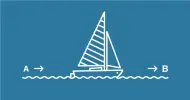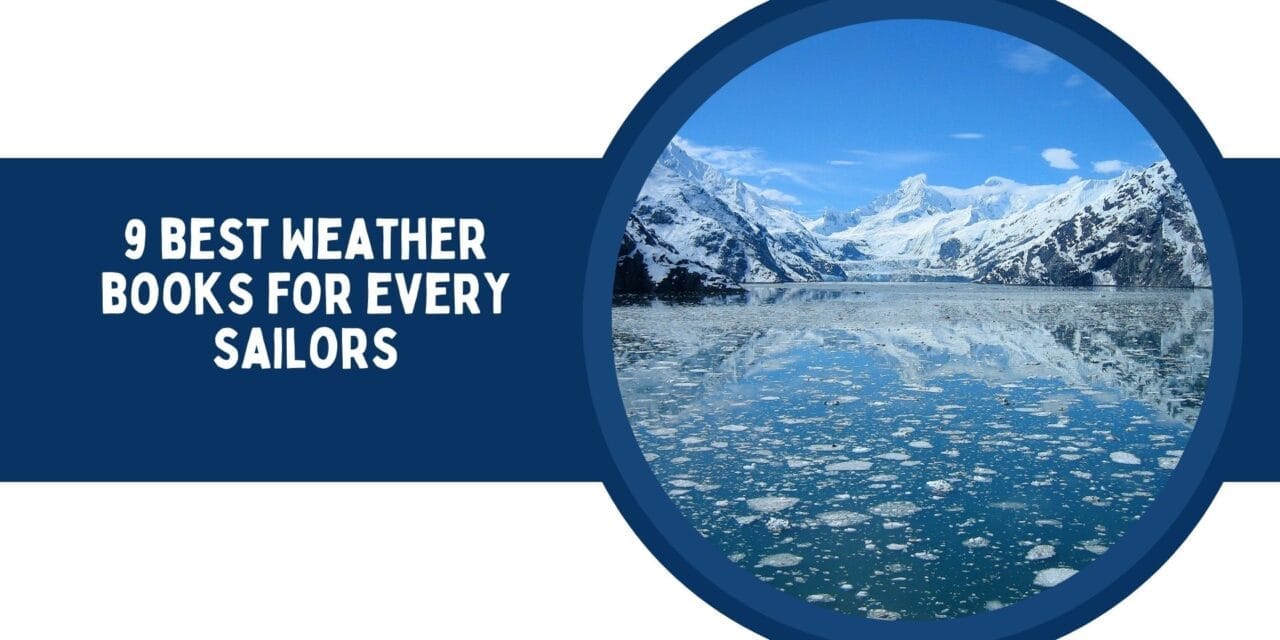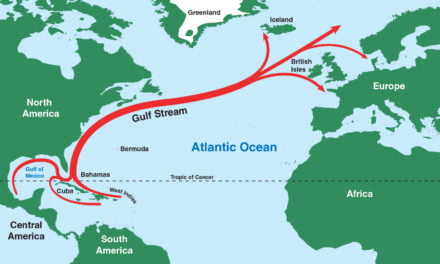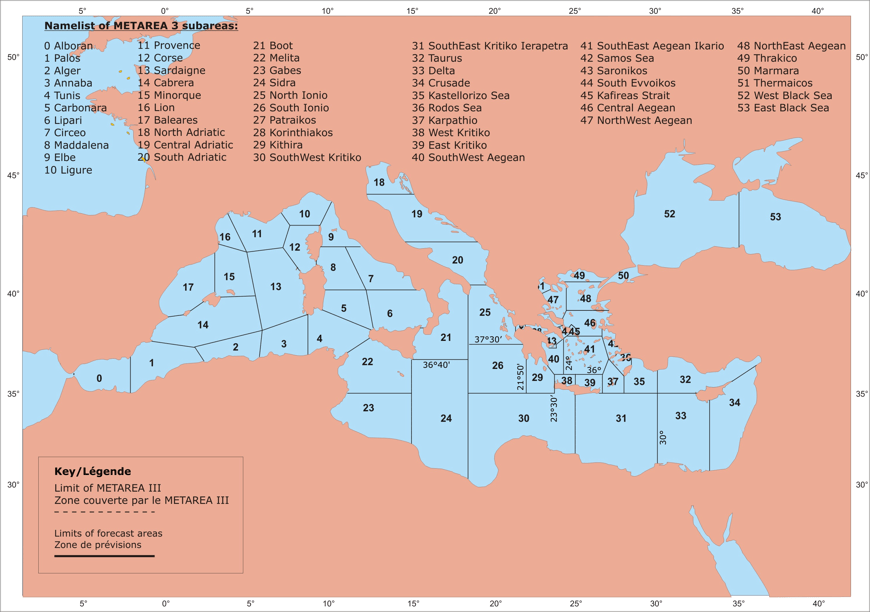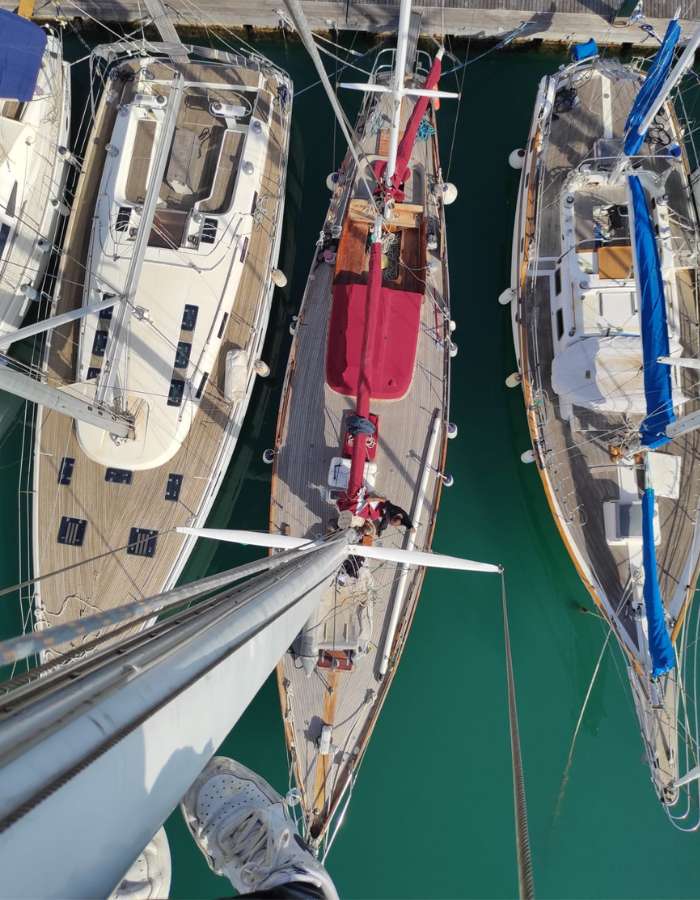9 Best Weather Books for Sailors You Need to Read
If you’re a sailor aiming to master marine weather, here are nine indispensable books. Start with the “RYA Weather Handbook” for a solid foundation. “Reading the Glass” blends storytelling with climate wisdom. “The Weather Handbook” offers detailed insights into weather formation. “The Sailor’s Book of the Weather” simplifies low-pressure systems. The “Mediterranean Weather Handbook” is a must for those exploring European waters. “Weather at Sea” and “Modern Marine Weather Book” bridge traditional skills with modern tech. Each book promises rich content, clear visuals, and practical advice. Immerse yourself in these resources to elevate your sailing expertise.
Key Takeaways
- RYA Weather Handbook: Beginner-friendly with comprehensive marine weather insights, ideal for RYA Yachtmaster Exam preparation.
- Reading the Glass: Engaging storytelling and educational content on complex weather phenomena, suitable for both casual readers and instructors.
- The Sailor’s Book of the Weather: Conversational style with clear illustrations, focusing on low-pressure systems and internet weather sites.
- Mediterranean Weather Handbook for Sailors: Detailed on weather forecasts and ocean currents, best for competitive sailing in Mediterranean conditions.
- Modern Marine Weather Book: Comprehensive with excellent illustrations, linking traditional skills and modern technology for sailors.
RYA Weather Handbook
For anyone new to boating or simply curious about how weather impacts the sea, the “RYA Weather Handbook” stands out as an essential read. Authored by Chris Tibbs, with his extensive experience in ocean sailing and meteorology, this book is a treasure trove for beginners. You’ll find it well-illustrated and easy to understand, typical of RYA publications. It’s especially useful if you’re prepping for the RYA Yachtmaster Exam. The handbook offers an all-encompassing introduction to marine weather and is continually updated. Value-wise, it’s worth every penny, arriving quickly and in perfect condition. Whether you’re planning an ocean passage or involved in sail-training expeditions, this book comes highly recommended. Don’t miss out on this top-quality RYA training book.
Best For: Anyone new to boating or curious about how weather impacts the sea.
| Pros: | Cons: |
| Comprehensive introduction to marine weather, continually updated. | Primarily aimed at beginners, may lack depth for advanced sailors. |
| Well-illustrated and easy to understand. | Specific to marine weather, not a general meteorology guide. |
| Helpful for preparing for the RYA Yachtmaster Exam. | Limited appeal to those not involved in boating or sailing. |
Reading the Glass: A Sailors Stories of Weather
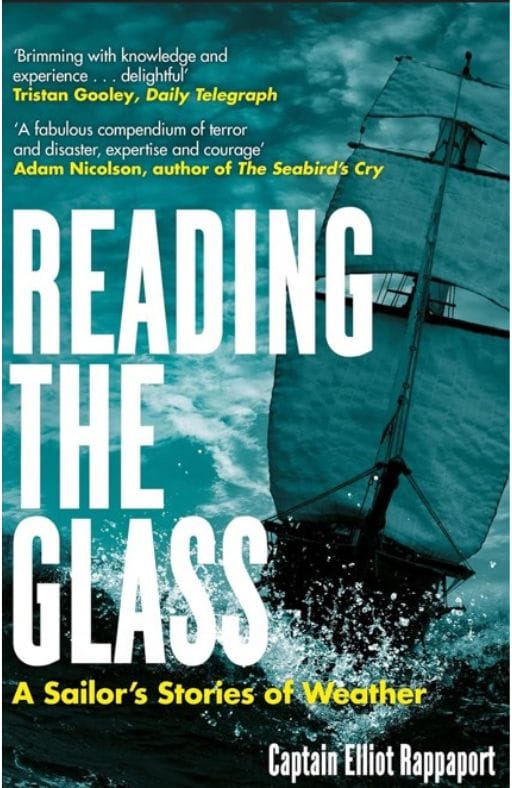
“Reading the Glass: A Sailor’s Stories of Weather” stands out as a must-read for sailors keen on deepening their understanding of weather patterns and their impact on nautical journeys. Elliot Rappaport’s engaging writing style and clear explanations of complex weather phenomena have earned high praise from readers like Kimberly Glomb. She admires Rappaport’s ability to make technical material accessible and enthralling, covering diverse locations such as New Zealand, Bora Bora, and the Arctic. The book’s educational value is undeniable; it has even inspired weather class instructors to incorporate its insights. Readers find the sailing stories riveting, offering a deep connection to life aboard a ship and the science of navigation. This book will leave you both informed and inspired.
Best For: Sailors and weather enthusiasts looking to deepen their understanding of weather patterns and their impact on nautical journeys.
| Pros: | Cons: |
| Engaging writing style that makes complex weather phenomena accessible. | May be too technical for readers with no interest in sailing or weather. But we are sailors, right? |
| Captivating storytelling that transports readers to various exotic locations. | Focuses primarily on nautical experiences, which might not appeal to novice sailors. |
| Educational value that inspires and informs both casual readers and weather class instructors. | Some readers might find the detailed weather explanations overwhelming without prior knowledge. |
The Weather Handbook: Essential Guide to Weather Formation and Development
The “Weather Handbook: Essential Guide to Weather Formation and Development” shines as a thorough resource for sailors with a keen interest in understanding meteorological processes. You’ll find it very educational, with lots of pictures to help you grasp complex concepts. While it’s a technical read, those invested in sailing will appreciate the detailed explanations of weather phenomena. However, be prepared for small, light grey print that’s tough to read without strong lighting. Some readers found it too advanced, suggesting it might stretch your knowledge if you’re not already familiar with terms like occluded fronts. If you’re looking for something more approachable, consider “Instant Weather Forecasting” by the same author. Still, for dedicated sailors, this handbook is worth the effort and study.
Best For: Sailors with a keen interest in understanding meteorological processes and willing to invest time in studying detailed weather phenomena.
| Pros: | Cons: |
| Very educational with lots of pictures. | Small, light grey print can be difficult to read without strong lighting. |
| Detailed explanations of weather phenomena. | May be too advanced for those not already familiar with meteorological terms. |
| Valuable resource for those whose activities depend on understanding the weather. | More of a technical study guide than a casual read. |
The Sailors Book of the Weather
“The Sailors Book of the Weather” is perfect for beginners interested in understanding the basics of maritime meteorology. You’ll find it easy to comprehend and well-written, with a conversational style that makes learning enjoyable. The book explores low-pressure systems, helping you identify changing conditions at sea. Clear illustrations and photos make forecasting simple, turning intricate concepts into easily understandable pieces. Additionally, it provides valuable information on internet weather sites, ensuring you’re always equipped with the most recent updates. By the end, you’ll have a strong foundation in comprehending weather patterns and how they influence sailing. If you’re looking to enhance your maritime meteorological knowledge from the ground up, this book is a must-read.
Best For: Beginners interested in learning the basics of maritime meteorology in an easy-to-understand and enjoyable manner.
| Pros: | Cons: |
| Chatty and conversational writing style. | Primarily focused on low-pressure systems. |
| Clear illustrations and photos for easy forecasting. | May be too basic for advanced users. |
| Provides guidance on using internet weather sites. | Limited coverage on non-maritime weather patterns. |
Mediterranean Weather Handbook for Sailors
Traversing the Mediterranean’s intricate weather patterns demands more than just basic knowledge; “Mediterranean Weather Handbook for Sailors” is perfect for race navigators who need detailed, thorough information. This handbook packs vital data on weather forecast availability and ocean currents, making it invaluable for competitive sailing. However, it’s challenging for the average cruiser and lacks practical advice on specific wind patterns like the meltemi in the Eastern Aegean or the winds around Gibraltar. Additionally, it doesn’t provide information on establishing weather windows for entering or leaving the Mediterranean. Suggestions for the upcoming third edition include adding these practical insights to attract more leisure sailors, making it a more all-encompassing guide for all seafaring enthusiasts.
Best For: Race navigators who require detailed and comprehensive information on Mediterranean weather patterns and ocean currents.
| Pros: | Cons: |
| Extensive information on weather forecast availability. | Difficult for the average cruiser to use. |
| Detailed data on ocean currents. | Lacks practical advice on specific wind patterns like the meltemi and winds around Gibraltar. |
| Invaluable resource for competitive sailing. | Missing information on establishing weather windows for entering or leaving the Mediterranean. |
Reeds Weather Handbook: For Sail and Power
For sailors seeking a compact yet informative guide to weather patterns, “Reeds Weather Handbook: For Sail and Power” stands out as an excellent choice. This neat, easily readable book is full of useful information, making it ideal for everyday use. Whether you’re standing on deck or at the quayside, it’s a handy reference that belongs on board every yacht.
The handbook provides a solid introduction to many weather systems seen in the UK, giving you a rough idea of near-future weather conditions. However, it’s not detailed enough for those needing in-depth information and may require additional reading for thorough understanding. Overall, it’s highly recommended for its practicality and usefulness as a quick reference in your work bag or skipper’s handbook.
Best For: Sailors looking for a compact, practical guide to understanding basic weather patterns and needing a handy reference for everyday use.
| Pros: | Cons: |
| Full of useful information in an easily readable format | Lacks detailed information for advanced users |
| Handy size for on-deck or quayside reference | Requires additional reading for in-depth understanding |
| Excellent for a quick and rough idea of near-future weather | Primarily focused on UK weather systems |
Weather at Sea: A Cruising Skipper’s Guide to the Weather
Sailors looking to deepen their understanding of maritime weather will find “Weather at Sea: A Cruising Skipper’s Guide to the Weather” an invaluable resource. This compact guide, praised by RYA and Yachtmaster instructors, translates complex meteorological concepts into practical knowledge for sailors. With less than 100 pages, it’s concise yet detailed, making it perfect for everyone from RYA Day Skippers to Yachtmaster candidates.
Author Simon Rowell’s passion for meteorology shines through, ensuring that both novice and experienced sailors will find value. The book’s practical approach to global, regional, and local weather patterns, combined with simple explanations of physics and phenomena, makes it a must-have for your cruising weather toolbox. Don’t miss out on this essential guide.
Best For: Sailors from novice to experienced levels, particularly those preparing for RYA Day Skipper to Yachtmaster examinations.
| Pros: | Cons: |
| Concise and easy to understand, with less than 100 pages. | May not cover extremely advanced meteorological details. |
| Translates complex meteorological concepts into practical sailing knowledge. | Limited to maritime weather, not applicable to other outdoor activities. |
| Authored by a passionate and knowledgeable meteorologist. | Physical book format may not appeal to those who prefer digital resources. |
Mediterranean Weather Handbook for Sailors
Whether you’re an experienced mariner or just starting your Mediterranean sailing adventures, the “Mediterranean Weather Handbook for Sailors” is an invaluable resource packed with essential information. The book provides simple descriptions of the main wind phenomena and covers all regions of the Mediterranean. You’ll find monthly wind roses for about 30 zones and a multilingual dictionary of meteorological terms (EN, FR, ES, IT). The appendices include weather prediction sources, though some users wish it listed more internet sites. Many sailors consider it indispensable for trip planning, despite its demanding nature. Although not available in Spanish, the handbook remains highly recommended and is seen as a gold mine of information for sailing the Mediterranean.
Best For: Experienced and novice sailors planning trips in the Mediterranean region.
| Pros: | Cons: |
| Provides simple descriptions of main wind phenomena. | Not available in Spanish despite its relevance to Spanish regions. |
| Includes monthly wind roses for about 30 zones. | Lacks a comprehensive list of internet sites for weather prediction. |
| Features a multilingual meteorological terms dictionary (EN, FR, ES, IT). | Users desire increased practicality and ease of use in real-world scenarios. |
Modern Marine Weather Book
The “Modern Marine Weather Book” stands out as an essential resource for mariners and skippers seeking to master the intricacies of marine meteorology. This book offers everything you need to know, from analyzing meteorological charts to predicting weather like an expert. It’s praised for excellent illustrations and simple explanations, making complex processes easy to grasp. You’ll find extensive coverage of air masses, 500-millibar pressure maps, sea states, and more. It seamlessly links old skills with new technology, guiding you to interpret data from recent advancements in meteorological science. Whether you’re planning coastal or ocean transits, this book is indispensable. Dr. G. Kruszewski from Gdynia Maritime University even recommends it for academic use. Consider getting a paper copy for the best illustration quality.
Best For: Mariners and skippers looking to master marine meteorology and improve their weather prediction skills.
| Pros: | Cons: |
| Comprehensive coverage of marine weather phenomena. | Some readers may prefer a paper copy for better illustration quality. |
| Excellent illustrations and simple explanations. | Kindle version might not do justice to detailed graphics and maps. |
| Links traditional skills with modern technology. | May be too detailed for casual weather enthusiasts. |
Factors to Consider When Choosing Weather Books for Sailors
When selecting weather books for your sailing journeys, concentrate on the author’s practical background and the quality of illustrations and diagrams. Guarantee the content is both detailed and clear, and verify if the book is easy to use onboard. Also, consider whether it covers the specific weather regions you’ll be exploring.
Author’s Practical Experience
Choosing weather books for sailors requires careful consideration of the author’s practical experience. You need to make sure the book is written by someone who knows what they’re talking about. Look for authors with hands-on experience in both sailing and meteorology. This combination guarantees that the advice and information provided are not just theoretical but grounded in real-world application.
Authors who have navigated challenging weather conditions at sea can offer invaluable insights and practical tips that come from personal experience. This kind of expertise can make a huge difference, especially when you’re faced with unpredictable weather. Their stories and strategies, drawn from countless hours on the water, can provide you with the confidence and knowledge needed to handle similar situations.
Moreover, authors with a background in marine meteorology bring a deep understanding of weather patterns and their specific impacts on sailing. Their dual expertise ensures that the information is both credible and highly relevant to your needs as a sailor. By choosing books written by these professionals, you’re more likely to get accurate, actionable advice that can enhance your safety and performance on the water.
Illustrations and Diagrams Quality
While an author’s practical experience is undeniably important, the quality of illustrations and diagrams in weather books for sailors can’t be overlooked. High-quality visuals play a significant role in helping sailors understand complex weather patterns and phenomena. Detailed diagrams make it easier to interpret weather charts, maps, and forecasts, which is vital for planning and safety at sea.
Clear and informative illustrations enhance the learning experience by making the content more accessible. When concepts like wind patterns, pressure systems, and cloud formations are visually represented, it’s much simpler to grasp and remember these crucial elements. You’ll find that well-designed diagrams not only improve comprehension but also aid in the retention and practical application of meteorological knowledge.
Quality illustrations and diagrams in weather books can make the difference between understanding and confusion. These visual aids provide a straightforward way to digest complicated information, making your learning journey more seamless and efficient. Essentially, when selecting a weather book for your sailing adventures, prioritize those with excellent illustrations and diagrams to ensure you’re fully equipped to interpret and respond to the ever-changing conditions at sea.
Content Depth and Clarity
Selecting the right weather book for your sailing needs hinges on two key factors: content depth and clarity. Content depth involves the level of detail provided, covering a wide range of meteorological topics and their impact on sailing. You need a book that delves into essential aspects like wind patterns, storm systems, and weather fronts, offering both broad and specific information.
Clarity is equally important. A book with clear explanations helps you understand complex weather phenomena and apply this knowledge practically at sea. It should avoid overwhelming you with technical jargon and instead use straightforward language that makes learning engaging and accessible.
A well-balanced weather book caters to both beginners and seasoned sailors by providing in-depth content paired with concise explanations. Clear illustrations, diagrams, and examples further enhance understanding, making abstract concepts more tangible.
Consider your current knowledge level when choosing a book. If you’re a novice, look for one that simplifies complex ideas without oversimplifying them. For experienced sailors, a book with advanced insights and detailed analyses can be invaluable. Striking the right balance between depth and clarity ensures you gain valuable insights and can confidently navigate any weather conditions.
Book’s Usability Onboard
When you’re out at sea, having a weather guide that’s user-friendly onboard can make all the distinction. First, search for a compact and portable guide. Space is valuable on a boat, and a bulky volume won’t serve you well. A smaller, lightweight guide fits easily in your gear and is quick to reference.
Next, clear illustrations and diagrams are vital. When weather conditions are challenging, you don’t want to struggle with intricate charts or unclear figures. Choose a guide that presents information in a simple, easily understandable format.
Practical advice and guidance on interpreting weather patterns are necessary. You need immediate, actionable insights, not theoretical musings. Make sure the guide offers concrete steps for reading and reacting to weather changes while at sea.
Durability is another crucial factor. A water-resistant, sturdy guide will withstand the marine environment, guaranteeing it remains a dependable resource throughout your journey.
Lastly, focus on marine-specific weather phenomena and forecasting. A guide customized to the unique conditions sailors encounter will enhance your safety and knowledge far more effectively than a general weather manual. By taking into account these factors, you’ll find a weather guide truly useful onboard.
Specific Weather Regions Covered
Understanding the specific weather regions you’ll be venturing into is crucial when selecting a weather book for your sailing escapades. When planning your journey, consider whether the book covers the areas you’ll sail through, such as the Mediterranean, North Atlantic, or Pacific Ocean. Sailing in different regions requires a grasp of unique weather patterns, wind systems, and climatic conditions.
Look for books that provide detailed information on these specifics. You’ll need practical insights and tips for maneuvering the weather challenges commonly encountered in your selected areas. Whether it’s comprehending the Mistral winds in the Mediterranean or the trade winds in the Pacific, ensure the book addresses these vital elements.
Specialized knowledge on microclimates, prevailing winds, and local weather phenomena is invaluable. A good weather book will delve into these details, giving you a clearer picture of what to anticipate. Choose books that focus on the weather conditions and forecasting intricacies of the specific seas or oceans you’ll be exploring. This enhances your understanding and preparedness for your journey, making your sailing experience safer and more enjoyable. Don’t leave port without equipping yourself with the right weather knowledge tailored to your destinations.
Conclusion
Sailing’s more than steering through waters—it’s about dancing with the elements. By diving into these weather books, you’ll sharpen your skills and deepen your understanding of nature’s whims. Picture the thrill of mastering a storm or the serenity of predicting a peaceful voyage. These reads aren’t just manuals; they’re keys to unraveling the ocean’s mysteries. So grab a book, set sail, and let the winds of knowledge fill your sails. Happy reading and even happier sailing!
